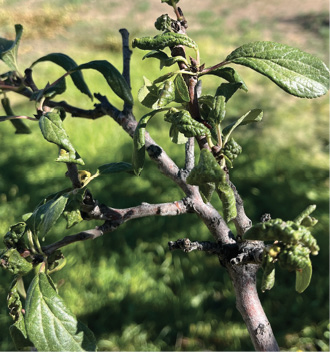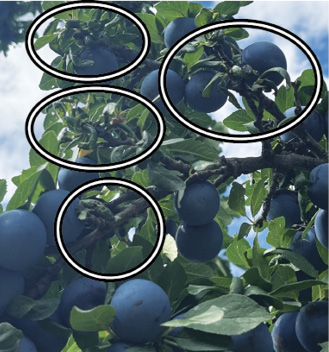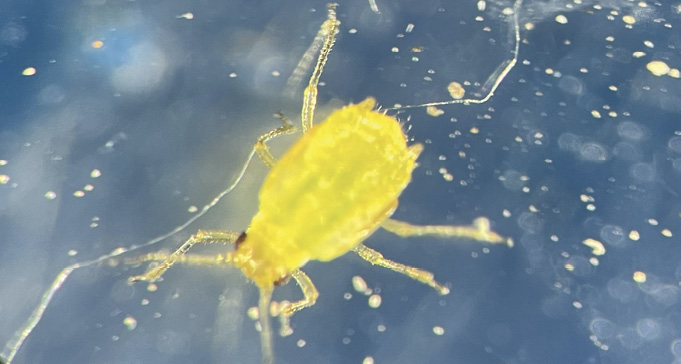Guide H-151
Joanie King and Phillip Lujan
College of Agricultural, Consumer and Environmental Sciences, New Mexico State University
Respectively, Assistant Professor and Extension Entomology Specialist, Entomology, Plant Pathology, and Weed Science; and Extension Plant Pathologist, Extension Plant Sciences. New Mexico State University. (Print-Friendly PDF)
Leaf curl plum aphids (Brachycaudus helichrysi) are a serious pest of Prunus spp. (i.e., stone fruits such as plums, peach, and cherry). They may infest any Prunus spp. but prefer domestic plum (Prunus domestica) and blackthorn (P. spinosa). They cause the leaves of Prunus trees to tightly curl, reducing overall vigor, and fruit production. In addition to being a pest of Prunus spp., these aphids are alternating pests of Asteraceae (e.g., chrysanthemums, thistle, sunflowers).



Identification
Often the leaf curling symptom is noticed before the leaf curl plum aphids (Figure 1 and 2). If leaf curling is observed, check leaves for aphids.
Eggs: Leaf curl plum aphid eggs are shiny, black, and about 0.5 mm long and 0.2 mm wide.
Nymphs (Immatures) and Adults: Leaf curl plum aphids are small insects that are pale in color (Figure 3). The nymphs, which are the immatures, look similar to adults but are smaller. The aphids are shiny and can be either green, yellowish green, brownish green, brownish yellow, or pinkish in color. The wingless form varies from 1.7-2.1 mm (0.06-0.08 inch) in length and the winged form ranges from 1.3-1.8 mm (0.05-0.07 in.) in length and darker in coloration.
Metamorphosis: Incomplete/simple. Immature insects (nymphs) are smaller but similar in form to the adults.
Mouth Parts: Piercing-sucking; these are long, straw-like appendages used to pierce into a substrate (e.g., plants) and suck up the plant juices (e.g., phloem).
Pest Stages: Nymphs, adults
Damage
Dense populations of leaf curl plum aphids can cause considerable damage to their Prunus host. All stages of the aphids—which includes nymphs, adults, and alates (winged aphids)—can feed, thus causing damage. Usually, distorted leaves or other damage to the plant are noticeable first before the aphids themselves (Figures 1 and 2).
Direct damage by the aphids is apparent by the curling of the leaves. Due to the curling of the leaves and their feeding (piercing-sucking mouthparts that suck up plant juices), foliage distorts, which can shed the flowers and cause the developing fruit to drop prematurely. Slowed tree growth, reduced fruit size, and reduced sugar content of fruit can also occur due to leaf curl plum aphid infestation.
Additionally, they excrete ample quantities of honeydew which may attract ants. Ants will in turn protect the aphids, preventing predators and parasitoids from attacking them. The excess honeydew can lead to sooty mold, which is a black fungal growth that appears on leaves, twigs, and other parts of the plant. Sooty mold can further lead to tree decline, a lackluster appearance, and an increased presence of ants. Other insects such as bees, flies, and wasps may also be attracted to the honeydew, further indicating that aphids may be present.
Life Cycle
Leaf curl plum aphids lay eggs in the fall and overwinter on and near the buds of Prunus spp. trees. The eggs can be very difficult to see due to their small size. Eggs hatch in the spring, around mid-March. The aphids continue to reproduce within the curled leaves and infest new growth until late May or early June; then they move from Prunus spp. trees to Asteraceae plants, which are their summer hosts. Then in the fall, the leaf curl plum aphid alates (winged aphids) will return to Prunus spp. trees and lay eggs.
Integrated Pest Management
The first step in preventing leaf curl plum aphid infestation is to maintain overall tree health. Healthy trees are less likely to become infested. Monitoring for leaf curl plum aphid is also important. This is particularly relevant in cases where a dormant spray has not been applied. Monitor for leaf curl plum aphid in spring, especially if they have been a problem in the past. Management is most effective before aphid populations build up and the leaves curl.
For homeowners with a few trees, strong sprays of water early in the growing season, before leaf curling is induced, can remove the aphids. Biological control is a part of aphid Integrated Pest Management (IPM). There are a variety of natural enemies of leaf curl plum aphid. These include lady beetles, brown lacewing larvae, green lacewing larvae, soldier beetles, hoverfly larvae, and parasitoid wasps. Most of these natural enemies are naturally occurring and can be encouraged through the use of conservation biological control. Conservation biological control is used to modify the environment in order to enhance natural enemies of pests already present in the environment. One way to do this is by using insectary plants to attract and sustain natural enemies (for further reading, see Guide H-169: Using Insectary Plants to Attract and Sustain Beneficial Insects for Biological Pest Control, https://pubs.nmsu.edu/_h/H169/index.html). Some natural enemies can be purchased through companies (e.g., online, garden centers) for the use of augmentative biological control. Augmentative biocontrol involves the mass rearing of natural enemies—such as predators, parasites, or pathogens—in a controlled environment, like a laboratory. These natural enemies are then released into areas where pests are causing damage. This method can provide a relatively quick solution for pest control, though it may require repeated releases since the natural enemies may not always establish a self-sustaining population, meaning it may not offer long-term pest management. It is important to note that boosting conservation biocontrol will encourage natural enemies more long term.
If biological control methods alone are not able to keep aphid populations down, insecticide treatment may be needed. Chemicals available include labeled insecticides for aphids such as oils (i.e., narrow range oil or neem oil) and insecticidal soaps. The best time to use chemical treatment is when the aphids are dormant in the late fall and/or early spring. In the early spring, monitor for aphids and apply treatments before the leaves curl. Chemical control with contact insecticides, such as neem oil, should be made before the leaves curl. Do not treat orchards in the summer; this is because the aphids are on their summer Asteraceae hosts.
Managing ants may be necessary in addition to leaf curl plum aphid management. This is because certain species of ants like to feed on the honeydew that the aphids produce. The ants will protect the aphids, which prevents natural enemies from eating the aphids. One way to manage ants is to use a sticky material painted on to trunk wraps. This form of physical control that will prevent ants from reaching the aphids in the tree branches. In some cases, chemical control may be needed. Baits may be used for ant control; keep in mind that the bait needs to be specific to the species of ant present. A common ant in New Mexico that may tend leaf curl plum aphis is the odorous house ant (Tapinoma sessile). If you have further questions, contact your county Extension office (https://extension.nmsu.edu/county.html).
For further reading
- Bennett, A. (2018). Using Insectary Plants to Attract and Sustain Beneficial Insects for Biological Pest Control [Guide H-169]. https://pubs.nmsu.edu/_h/H169/index.html
- Bennett, S. H. (1955). The Biology, Life History and Methods of Control of the Leaf Curling Plum Aphid Brachycaudus Helichrysi (KLTB.). Journal of Horticultural Science, 30(4), 252–259. https://doi.org/10.1080/00221589.1955.11513848
- Blackman, R.L., & Eastop, V.F. (2000). Aphids on the world’s crops: an identification and information guide. New York, NY: Willey and Sons.
- Gratwick, M. (1992). Plum aphids. In M. Gratwick (Ed.), Crop Pests in the UK: Collected edition of MAFF leaflets (56-59). Dordrecht: Springer Netherlands.
- Badenhausser, I. (1996). Sequential Sampling of Brachycaudus helichrysi (Homoptera: Aphididae) in Sunflower Fields. Journal of Economic Entomology, 89(6), 1460–1467. https://doi.org/10.1093/jee/89.6.1460
- Kök, Ş., & Kasap, İ. (2022). Interactions of predatory coccinellids (Coleoptera: Coccinellidae) and aphids (Hemiptera: Aphididae) in pome and stone fruit orchards of Çanakkale Province. Plant Protection Bulletin, 62(1), 5-11.
- Seethapathy, P., Gothandaraman, R., Gurudevan, T., & Malik, I. A. (2022). Diseases, pests, and disorders in plum: diagnosis and management. In A. Gull, G.A. Nayik, S.M. Wani, & V. Nanda (Eds.), Handbook of Plum Fruit: Production, Postharvest Science, and Processing Technology (133-176). CRC Press.
- Symmes, E. J., Dewhirst, S. Y., Birkett, M. A., Campbell, C. A., Chamberlain, K., Pickett, J. A., & Zalom, F. G. (2012). The sex pheromones of mealy plum (Hyalopterus pruni) and leaf-curl plum (Brachycaudus helichrysi) aphids: identification and field trapping of male and gynoparous aphids in prune orchards. Journal of Chemical Ecology, 38, 576-583.

Joanie King is a Research Scientist in the Department of Entomology Plant Pathology and Weed Science at New Mexico State University. She received her M.S. in Ecology and Ph.D. in Entomology from the University of Florida. Dr. Bowers is interested in the adoption, integration, and economic impact of biological control of weeds and insects in rangelands and orchards in New Mexico.
To find more resources for your business, home, or family, visit the College of Agricultural, Consumer and Environmental Sciences on the World Wide Web at pubs.nmsu.edu/
Contents of publications may be freely reproduced for educational purposes. All other rights reserved. For permission to use publications for other purposes, contact pubs@nmsu.edu or the authors listed on the publication.
New Mexico State University is an equal opportunity employer and educator. NMSU and the U.S. Department of Agriculture cooperating.
July 2025, Las Cruces, NM


